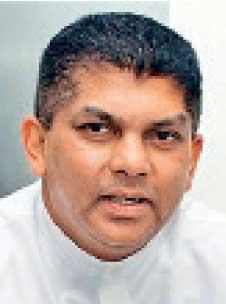Reply To:
Name - Reply Comment
“Hangman, slack your rope awhile…”
The recent fantasized prison tragedy, ‘Lady goes to Gallows’ reminds a line in the traditional Appalachian old time folk song, “The Maid Freed from the Gallows”— it’s about a damned maiden pleading, “Hangman, hangman, hold it a little while; Think I see my friends coming”
folk song, “The Maid Freed from the Gallows”— it’s about a damned maiden pleading, “Hangman, hangman, hold it a little while; Think I see my friends coming”
Over the conduct of a minister inside the Anuradhapura prison, where he threatened to kill two LTTE prisoners by brandishing a gun against their heads, six days after his raid on Welikada accompanied by few others including a “lady”—it appears that the Prisons Department suppressed both incidents [as part of a cover-up manoeuvre?] enabling him to continue in his position as State’s Gem Minister. An opportunity to observe a gibbet [gallows] is a ‘privilege’ unlike in the era of public executions. Hundreds of thousands visited ‘The Gibbet of Montfaucon’, [where Victor Hugo’s creation Esmeralda, in his masterpiece ‘The Hunchback of Notre Dame’ was hanged] the France’s 13th Century-built Gallows, until it was eventually dismantled ignoring the demand for future expositions, by cultured French authorities who realized its immoral factor.
Minister Ali Sabry said that the Cabinet had decided to appoint a High Court Judge [retired] to investigate and report. Come, Come, Mr. Sabry, can you think of a human being, a male, let it be by day or under moonlight, in longs or shorts; who will say “NO” to a woman, after a session of Scotch or Cognac with a few buddies; who insists that she visit the gallows and take a good look at the Gibbet’s ‘Rope and the Knot?” All human beings are born free and equal in dignity, why only the prisoners? Politicians too! Now he is free to oblige a ‘lady’ longing for a glimpse of emeralds, sapphires & rubies?
Black July’s Welikada Massacre
 All prisoners of varied races and religions lived together in harmony, without any divisive prejudices, until the International Court of Jurists requested the transfer of a group of LTTE suspects detained under the PTA at the army Camp in Panagoda, to Welikada, in July 1983. On July 23, a bomb was detonated by LTTE, targeting an army vehicle at Thinnaveli in Jaffna, killing 13 Army men. The bodies were flown to Colombo the next day igniting anti-Tamil pogroms in the city. Hooligans, instigated by a minister, went on a burning and killing spree. 53 LTTE suspects were cruelly attacked and killed by Sinhalese inmates inside the Prison.
All prisoners of varied races and religions lived together in harmony, without any divisive prejudices, until the International Court of Jurists requested the transfer of a group of LTTE suspects detained under the PTA at the army Camp in Panagoda, to Welikada, in July 1983. On July 23, a bomb was detonated by LTTE, targeting an army vehicle at Thinnaveli in Jaffna, killing 13 Army men. The bodies were flown to Colombo the next day igniting anti-Tamil pogroms in the city. Hooligans, instigated by a minister, went on a burning and killing spree. 53 LTTE suspects were cruelly attacked and killed by Sinhalese inmates inside the Prison.
In international law, Prisoners’ rights are established in a number of treaties that came into existence following the World Wars and the body of law goes on adding to or amending them. The Standard Minimum Rules originally adopted by the 1st UN Congress on the Treatment of Offenders in 1955, comprise the rules for prison facilities and the treatment of prisoners. It has been of tremendous influence in the progress of prison laws and practices. However, the Minimum Rules adopted by the UN symbolised, A/RES/70/175 not only adopted the revised Standard Minimum Rules, but also accepted that they should be known as the “Nelson Mandela Rules” in order to honour the legacy of the Statesman. Nelson Mandela, South Africa’s anti-apartheid revolutionary, their first black head of state and statesman who served 27 years in prison said, “No one truly knows a nation until one has been inside its jails.”
"In international law, Prisoners’ rights are established in a number of treaties that came into existence following the World Wars and the body of law goes on adding to or amending them. The Standard Minimum Rules originally adopted by the 1st UN Congress on the Treatment of Offenders in 1955, comprise the rules for prison facilities and the treatment of prisoners"
Basic principle rule 1 says: “All prisoners shall be treated with the respect due to their inherent dignity and value as human beings. No prisoner shall be subject to, and all prisoners shall be protected from, torture and other cruel, inhuman or degrading treatment or punishment. The safety and security of prisoners, staff, service providers and visitors shall be ensured at all times. All persons deprived of their liberty shall be treated at all times with kindness and with respect for the natural dignity of the human person. Any person, who alleges that he or she has been subject to suffering, has the right to protest and to have the case quickly and impartially examined by a competent establishment.”
Our Pitiable Past Record
Angunakolapelessa in 2017: the authorities ruthlessly crushed a protest by a group of prisoners against the conduct of the Prison Superintendent on November 22. The protesting prisoners had claimed the STF men even strip-searched their visitors. The trouble began when the prison authorities had ruthlessly beaten up inmates protesting against the conduct of the Prison Superintendent. Several video clips showed the police and prison authorities attacking the protestors and prisoners were shown with their hands raised, kneeling down in front of armed guards. Thalatha Athukorale, the then Justice and Prisons Reforms Minister, announced the appointment of two committees to inquire into the assault. However, she seemed more interested in investigating who had leaked the video footage and punishing the ‘culprit’. The findings of the two commissions are gathering dust under a cupboard.
Welikada in 2012: Around 250 commandos from the STF arrived at the prison on November 9, to assist prison guards in a search and despite protests from prisoners, recovered drugs and mobile phones within the premises. As it continued, fighting broke out between the STF commandos and the prisoners. STF tried to suppress them by using tear gas, but all efforts failed. The prisoners took control and a siege ensued with some officials being held hostage. By evening, the prisoners broke into the armory and removed assault rifles and ammunition, leading to heavy gunfights. The army was called in, and the STF joined them in storming the prison and regaining control. 27 prisoners had been killed in the confrontation. Commissions and committees of investigation were of no avail.
Bindunuwewa in 2000: The Prison was a low-security detention centre, established to detain LTTE cadres. On October 24, a few hundred villagers with knives, rods and torches stormed the centre and massacred the detainees resulting in the deaths of 26 LTTE political prisoners. The CBK government responded saying that the prisoners had become violent and were creating unrest, resulting in an attempt to control the rioting, and charged a few police officers with the crime. They were convicted of murder, but were subsequently released by the Supreme Court.
The Kalutara Riots in 1997: Occurred at the high-security prison in Kalutara, on December 12. Three Tamil political prisoners were killed by Sinhalese prisoners. No one has yet been convicted for these crimes.
Imprison the 225!
Two prisoners including a former LTTE cadre have got through their GCE (O/L); and on previous occasions some have completed their postgraduate studies as well. Mr. President, pardon and release them before another benighted soul storm their abode and terrify them in an ‘isolated incident’. As usually happens, in the course of time, the Ratwatte issue would be swept under the carpet and forgotten. Politicians, who politicized the police, are now politicizing the prisons: there is a clarion call by the people—“imprison the 225!” In the absence of stringent punitive action—they would add one more to the total.
[‘Maid Freed from the Gallows’-- https://www.youtube.com/watch?v=6YIp0h7PIlo]Vn4]
[email protected]